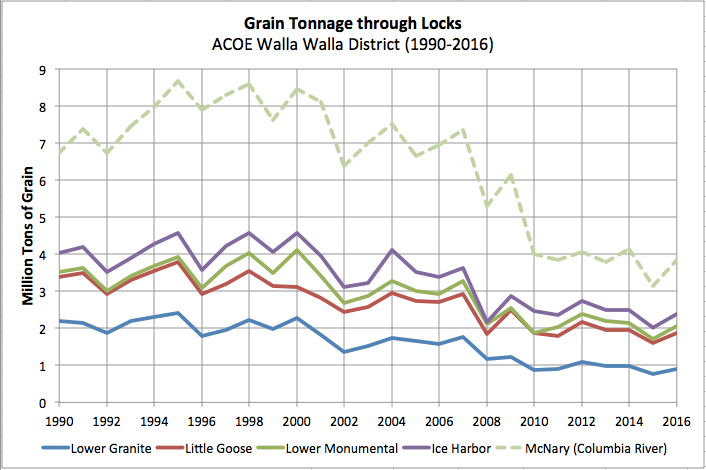forum
library
tutorial
contact

Push is On to Tear Down Dams to Save
Salmon and Orcas. Why These People Say It's a Bad Idea
by Annette Cary
Tri-City Herald, May 14, 2019
|
the film forum library tutorial contact |

|
Push is On to Tear Down Dams to Save
by Annette Cary
|
"We're outnumbered by the other side of the state where people see dam breaching as the obvious solution," Newhouse said.
 Taking out the lower Snake River dams would have consequences that would be difficult to overcome, while offering little help to salmon and orcas.
Taking out the lower Snake River dams would have consequences that would be difficult to overcome, while offering little help to salmon and orcas.
That was the message from speakers assembled in Richland on Monday night by Rep. Dan Newhouse, R-Wash. They discussed the dams and answered questions from about 100 people who attended the public session.
Breaching the dams is being considered in a federal environmental study ordered by a federal judge as a way to help endangered salmon. It's also been proposed as a way to increase the chinook salmon that are the primary food for the iconic southern resident orca whale population along the Washington coast.
"We're outnumbered by the other side of the state where people see dam breaching as the obvious solution," Newhouse said.
But National Oceanic and Atmospheric Administration Fisheries scientists have said that breaching the four Lower Snake dams, starting at Ice Harbor near Burbank, would have a marginal effect on the orcas, said Todd Myers of the Washington Policy Center, a conservative think tank.
NOAA has ranked the most important watersheds for the orcas, with the Snake River coming in at number nine, he said.
ELWHA DAM IS BREACHED
"The (orcas') main habitat, their most critical habitat, is the Puget Sound," said Gary Chandler, vice president of government affairs for the Association of Washington Business and a member of the state's Southern Resident Orca Task Force. "What are we doing about the water quality of the Puget Sound?"
The removal of the Elwha Dam upstream from the mouth of Elwha River on the Strait of Juan de Fuca in 2012 could indicate what could be expected from the removal of the lower Snake dams, Myers said.
At least to date, there has been no benefit, he said.
Before the dam was taken down, 96 percent of returning fish were hatchery raised. That percentage had not changed five years later, he said.
There have been calls for the Trump administration to convene an Environmental Species Act committee, or "God Squad," with the power to put an end to the escalation of requirements to protect Columbia and Snake river fish runs.
However, Newhouse said he does not see that as a political reality.
NEWHOUSE: IDAHO HAS ITS OWN ISSUES
Republican Rep. MIke Simpson, of Idaho, has called for breaching of the lower Snake dams to be considered.
But Newhouse called for him to get his own house in order.
"What he didn't mention is our dams have the world's most innovative fish passage system, while not a single dam in Idaho has fish passage," Newhouse said.
Tearing down the dams would be devastating to the way of life for many in Eastern Washington, he said.
Among their benefits are making the Snake navigable through Washington state.
Kristin Meira, representing the Pacific Northwest Waterways Association, said claims that shipping on the Snake River has declined are false.
The tonnage shipped on the river has remained stable over the past decade, she said.
FARMERS FEAR LOSS OF DAMS
Even in 2017 when dam locks were closed for three months for upgrades, 3.5 million tons of cargo were moved in the nine months they were open. It would have taken 135,000 rail cars to move that cargo, and that rail capacity is not available, she said.
Adding rail capacity is not as easy as it sounds, said David Reeploeg, vice president of federal programs for the Tri-City Development Council. It would be expensive, and there would be impacts for communities.
The Columbia and Snake waterway is the nation's largest wheat export gateway and the third-largest grain gateway in the world, Newhouse said. It moves the equivalent of 700,000 trucks traveling down the Columbia Gorge, he said.
It's not just interstates but also small rural roads that would see increases in truck traffic without barges to move wheat, Newhouse said.
Brian Cochran of the Washington Grain Commission said he drives 12 minutes from his farm to deliver grain to the port by the Ice Harbor Dam. Without it he would be moving 12 million pounds of wheat on the "rabbit trail" that is the Pasco-Kahlotus Highway, he said.
Margins for wheat farmers are so tight, he said, that they need the option of barging to be affordable to get their wheat to market.
learn more on topics covered in the film
see the video
read the script
learn the songs
discussion forum
